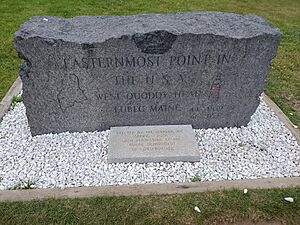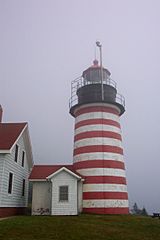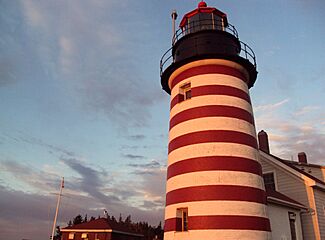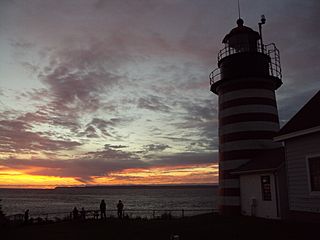West Quoddy Head Light facts for kids
 |
|
| West Quoddy Head Light, with Grand Manan in the background | |
| Location | West Quoddy head/Bay of Fundy |
|---|---|
| Coordinates | 44°48′54.4″N 66°57′1.7″W / 44.815111°N 66.950472°W |
| Year first constructed | 1808 |
| Year first lit | 1858 (Current tower) |
| Automated | 1988 |
| Foundation | Masonry |
| Construction | Brick |
| Tower shape | Conical |
| Markings / pattern | Red and white bands with black lantern |
| Height | 49 ft (15 m) |
| Focal height | 83 ft (25 m) |
| Original lens | Third order Fresnel lens |
| Intensity | 35,000 candela |
| Range | 18 nmi (33 km; 21 mi) |
| Characteristic | Flashing(2) White 15s |
| Fog signal | HORN: 2 every 30s |
West Quoddy Head is a very special place in Lubec, Maine. It is the easternmost point of the entire contiguous United States! Imagine being able to say you've stood at the very edge of the country.
A lighthouse was first built here in 1808. Its job was to help ships find their way safely through the tricky waters of the Quoddy Narrows. The lighthouse you see today, with its famous red-and-white stripes, was built in 1858. It still works as an important guide for ships today. Inside, it uses a special Fresnel lens to make its light shine brightly. This particular lens is one of only eight still used on the Maine Coast.
This historic lighthouse, known as the West Quoddy Head Light Station, was added to the National Register of Historic Places on July 4, 1980. This means it's recognized as an important historical site worth protecting.
Contents
Exploring West Quoddy Head
West Quoddy Head is a piece of land that points east into the ocean. It's located in southeastern Lubec, Maine. From here, you can look out over the Quoddy Narrows. This is a narrow strait of water between Lubec and Campobello Island in Canada.
The narrows are like a watery highway. They lead to Passamaquoddy Bay and other rivers. Most of this area is now part of Quoddy Head State Park. The lighthouse stands proudly near the southern end of this eastern coastline.
You'll find a stone sign that proudly declares this spot as the "easternmost point in the U.S.A." While the sign refers to the land, the actual easternmost point includes some rocks that stretch out even further into the sea. The lighthouse area includes the tall tower, the old house where the lighthouse keeper lived, and other small buildings.
The Lighthouse Tower
The lighthouse tower is round and stands 49 feet (15 m) tall. Its light shines from 83 feet (25 m) above sea level. The powerful light, made even brighter by its special Fresnel lens, can be seen from up to 18 miles (29 km) away.
The tower is made of brick. It's painted with bright red and white stripes that go all the way around. A small brick entrance sticks out from the tower. The keeper's house, a wooden building, is one and a half stories tall.
A Look at History
The idea for a lighthouse at West Quoddy Head was approved by the U.S. Congress in 1806. The first lighthouse was finished on April 21, 1808. It cost $5,000 to build back then.
In 1820, Congress also approved the first fog signal for the station. This was a 500-pound (230 kg) bell, which cost $1,000. The current, taller tower was built in 1858. The old keeper's house is now a museum and a visitor's center. It's a great place to learn more about the lighthouse!
In 1990, the U.S. Postal Service even honored the West Quoddy Head Light. They put its picture on a 25-cent postage stamp.
Lighthouse Keepers
Many dedicated people have worked as keepers at West Quoddy Head Light. They lived at the station and made sure the light kept shining to guide ships.
- The very first keeper was Thomas Dexter.
- In 1939, Howard Grey was the last civilian keeper. After him, the U.S. Coast Guard took over.
- In 1988, Malcolm Rouse from the U.S. Coast Guard was the last keeper. After him, the lighthouse became automated, meaning machines took over its operation.
See also
- National Register of Historic Places listings in Washington County, Maine
- Head Harbour Lighthouse - This is another lighthouse, sometimes called East Quoddy Head Light, located on the Canadian side of the water.






